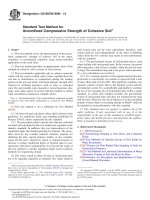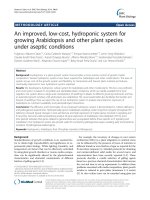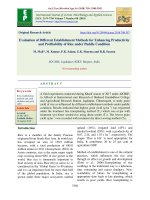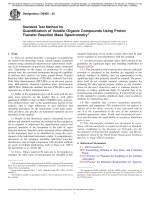ASTM D280-01 (2023) Standard Test Methods for Hygroscopic Moisture (and Other Matter Volatile Under the Test Conditions) in Pigments
Bạn đang xem bản rút gọn của tài liệu. Xem và tải ngay bản đầy đủ của tài liệu tại đây (190.45 KB, 2 trang )
This international standard was developed in accordance with internationally recognized principles on standardization established in the Decision on Principles for the
Development of International Standards, Guides and Recommendations issued by the World Trade Organization Technical Barriers to Trade (TBT) Committee.
Designation: D280 − 01 (Reapproved 2023)
Standard Test Methods for
Hygroscopic Moisture (and Other Matter Volatile Under the
Test Conditions) in Pigments1
This standard is issued under the fixed designation D280; the number immediately following the designation indicates the year of
original adoption or, in the case of revision, the year of last revision. A number in parentheses indicates the year of last reapproval. A
superscript epsilon (´) indicates an editorial change since the last revision or reapproval.
This standard has been approved for use by agencies of the U.S. Department of Defense.
1. Scope from 3 g to 5 g of the pigment in the clean, dry weighing bottle
or in the clean, dry aluminum moisture dish. Insert the stopper
1.1 These test methods cover procedures for determining (or cover) and weigh to 0.1 mg. Subtract the weight of the
hygroscopic moisture (and other matter volatile under the test vessel from the total weight to obtain the weight of sample
conditions) in pigments. used in the test. Remove the stopper (or cover) and place it and
the bottle (or dish) containing the specimen in an oven that has
1.2 The values stated in SI units are to be regarded as been previously heated to 110 °C 6 2 °C, heat for 2 h at a
standard. No other units of measurement are included in this temperature of 105 °C to 110 °C. Replace the stopper (or
standard. cover), cool in a desiccator, and weigh. Calculate the total loss
in weight as percent of moisture and other volatile matter.
1.3 This standard does not purport to address all of the
safety concerns, if any, associated with its use. It is the METHOD B—FOR PIGMENTS THAT DECOMPOSE
responsibility of the user of this standard to establish appro- AT 110 °C
priate safety, health, and environmental practices and deter-
mine the applicability of regulatory limitations prior to use. 4. Apparatus
1.4 This international standard was developed in accor- 4.1 Weighing Bottle, glass, as described in 2.1.
dance with internationally recognized principles on standard-
ization established in the Decision on Principles for the 4.2 Open-Tube Manometer made of glass tubing 6 mm in
Development of International Standards, Guides and Recom- diameter, filled with mercury to approximately 860 mm, fitted
mendations issued by the World Trade Organization Technical with rubber pressure tubing attached to a T-joint leading to the
Barriers to Trade (TBT) Committee. desiccator and the pump. A suitable low-pressure gauge may be
used in place of the manometer.
METHOD A—FOR PIGMENTS THAT DO NOT
DECOMPOSE AT 110 °C NOTE 1—The difference in levels of the mercury in the manometer
when the system is in operation, subtracted from the barometer reading
2. Apparatus taken at the same time, gives the pressure of the system in millimetres of
mercury.
2.1 Weighing Bottle, wide-mouth, cylindrical, glass (flat
form, about 30 mm in height and about 70 mm in diameter), 4.3 Desiccator, glass, having a hole at the side or in the
provided with a ground-in glass stopper. Or, an aluminum cover, constructed with heavy walls to withstand a vacuum of
moisture dish (about 90 mm in diameter and about 50 mm in one atmosphere. The hole at the side shall be closed with a
depth) with a tightly fitting cover. one-hole rubber stopper carrying a glass tube with a rubber
tube connection and a pinchcock or with a glass stopcock
2.2 Oven in which a temperature of from 110 °C 6 2 °C is ground to fit the tubulature.
maintained.
4.4 Oil Vacuum Pump, 2 able to achieve and hold a vacuum
2.3 Analytical Balance. of 3 mm.
3. Procedure 4.5 Analytical Balance.
3.1 Weigh accurately the glass weighing bottle and stopper 2 The sole source of supply of the “Hyvac” oil pump known to the committee at
or the aluminum moisture dish with cover. Place a specimen of this time is HyVac Products, Inc., P.O. Box 389, Phoenixville, PA 19460–0389. If
you are aware of alternative suppliers, please provide this information to ASTM
1 These test methods are under the jurisdiction of ASTM Committee D01 on International Headquarters. Your comments will receive careful consideration at a
Paint and Related Coatings, Materials, and Applications and are the direct meeting of the responsible technical committee,1 which you may attend.
responsibility of Subcommittee D01.31 on Pigment Specifications.
Current edition approved June 1, 2023. Published June 2023. Originally
approved in 1928. Last previous edition approved in 2019 as D280 – 01 (2019).
DOI: 10.1520/D0280-01R23.
Copyright © ASTM International, 100 Barr Harbor Drive, PO Box C700, West Conshohocken, PA 19428-2959. United States
D280 − 01 (2023)
5. Procedure pinchcock or stopcock, remove the cover, quickly replace the
stopper in the weighing bottle, and weigh. Repeat the evacu-
5.1 Weigh accurately the glass weighing bottle and stopper. ations and weighings until the loss in weight does not exceed
Place a specimen of from 1 g to 3 g of the pigment in the clean, 0.5 mg in 24 h. Calculate the total loss in weight as percent of
dry weighing bottle, insert the stopper and weigh to 0.1 mg. moisture and other volatile matter (Note 3).
Subtract the weight of the vessel from the total weight to obtain
the weight of sample used in the test. NOTE 2—Caution should be used in evacuating glass desiccators. The
vacuum should be applied gradually. Desiccators will maintain a vacuum
5.2 Remove the stopper and place it and the bottle contain- for a greater length of time when a thin film of a suitable stopcock
ing the specimen in the desiccator containing fresh, anhydrous lubricant is applied to the ground surfaces. Desiccators when evacuated
magnesium perchlorate.3 Close the desiccator, attach to the should be wrapped in towels or covered by other means to prevent
pump, and gradually evacuate until the pressure is constant at possible injury to the operator.
3 mm or less (Note 2). Close the pinchcock or stopcock, stop
the pump, and let stand at room temperature (21 °C to 32 °C) NOTE 3—This is an empirical method and the details should be strictly
for 24 h. followed. The determination of the true hygroscopic moisture content of
very finely divided pigments is very difficult, if not impossible in some
5.3 Slowly admit air that has been dried by passage through cases.
fresh magnesium perchlorate to the desiccator by means of the
6. Keywords
3 Available from Chemical Suppliers under the name Anhydrous or Dehydrite.
6.1 moisture; pigment; volatile
ASTM International takes no position respecting the validity of any patent rights asserted in connection with any item mentioned
in this standard. Users of this standard are expressly advised that determination of the validity of any such patent rights, and the risk
of infringement of such rights, are entirely their own responsibility.
This standard is subject to revision at any time by the responsible technical committee and must be reviewed every five years and
if not revised, either reapproved or withdrawn. Your comments are invited either for revision of this standard or for additional standards
and should be addressed to ASTM International Headquarters. Your comments will receive careful consideration at a meeting of the
responsible technical committee, which you may attend. If you feel that your comments have not received a fair hearing you should
make your views known to the ASTM Committee on Standards, at the address shown below.
This standard is copyrighted by ASTM International, 100 Barr Harbor Drive, PO Box C700, West Conshohocken, PA 19428-2959,
United States. Individual reprints (single or multiple copies) of this standard may be obtained by contacting ASTM at the above
address or at 610-832-9585 (phone), 610-832-9555 (fax), or (e-mail); or through the ASTM website
(www.astm.org). Permission rights to photocopy the standard may also be secured from the Copyright Clearance Center, 222
Rosewood Drive, Danvers, MA 01923, Tel: (978) 646-2600; />
2






